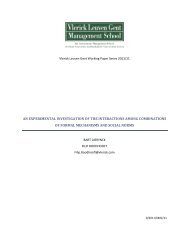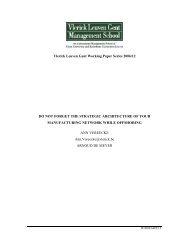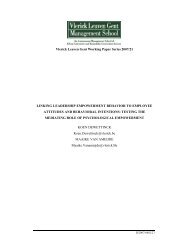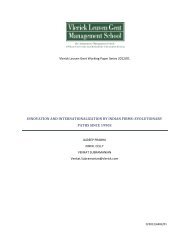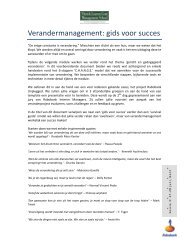Vlerick Leuven Gent Working Paper Series 2007/03 ... - Vlerick Public
Vlerick Leuven Gent Working Paper Series 2007/03 ... - Vlerick Public
Vlerick Leuven Gent Working Paper Series 2007/03 ... - Vlerick Public
You also want an ePaper? Increase the reach of your titles
YUMPU automatically turns print PDFs into web optimized ePapers that Google loves.
Its main duties lie in supervision, control and (strategic) advice. The second tier is<br />
formed by the board of management and is responsible for execution of the strategic<br />
decisions. It is defensible to take these differences into account in exploring board processes<br />
and consequently in determining the effectiveness of boards.<br />
Second, the proposed relationships within our framework are not exclusive. In spite of<br />
the fact that the identified intervening variables are separate constructs, we acknowledge the<br />
possibility that they can influence each other. For example, when board members air their<br />
ideas in open discussions, the danger of groupthink diminishes. Conversely, boards that are<br />
more fragmented, may be hampered in conveying debate while directors feel less motivated to<br />
make an effort to contribute. In addition, it can be stated that not all of the relationships may<br />
be one-directional and for instance, board outcomes reciprocally impact board structure.<br />
When the strategic or monitoring tasks are not carried out in a sufficient manner, the board<br />
will likely decide to change the composition of the board. Still, it is more difficult to predict<br />
the exact nature and strength of these relationships among the variables.<br />
Third, we have integrated only a limited number of process variables into the model of which<br />
we believe are the most relevant for studying board effectiveness. More specificially, we have<br />
distinguished three intervening variables, namely cohesiveness, debate and conflict norms. However,<br />
there exists a variety of other process variables that have been identified in (group) literature but that<br />
are not included in our board model. Examples are internal task process (Ancona and Caldwell, 1992),<br />
use of knowledge and skills (Forbes and Milliken, 1999), decision-making attention (Golden and<br />
Zajac, 2001) and decision comprehensiveness (Simons et.al., 1999). Nevertheless, they also offer<br />
interesting avenues for further research, particularly from the angle of the decision-making process. It<br />
might be worthwhile to explore to what extent these variables contribute to our model of board<br />
effectiveness next to the ones that we have selected.<br />
Fourth, it must be noted that the static nature of input-process-output models of group<br />
effectiveness has raised critical questions and there is a plea to pay more attention to the<br />
dynamic nature of group systems (Ruigrok and Tacheva, 2004). Demb and Neubauer (1992)<br />
already touched upon this issue by introducing the ‘reinforcing loop’ in order to<br />
conceptionalize the findings of their directors’ poll. Although we value their approach,<br />
mapping board models that way, it is not evident to detect the determining variable that<br />
reinforces either positive or negative cycles of board behaviour. Perhaps longitudinal research<br />
methods may shed more light on this interdependence nature of dynamic board systems.<br />
24



